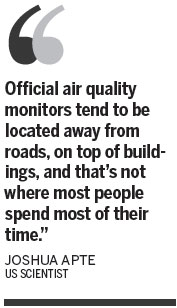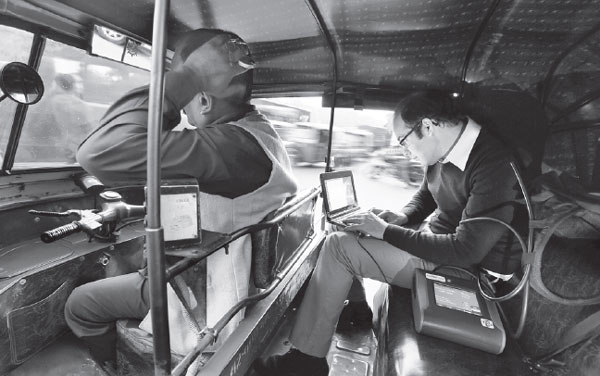Scientist exposes New Delhi's air quality
Monitoring from back of rickshaw reveals high levels of PM2.5 on roads
A three-wheeled rickshaw lurched through New Delhi's commuter-clogged streets with a US scientist and several air pollution monitors in the back seat. Car horns blared. A scrappy scooter buzzed by belching black smoke from its tailpipe. One of the monitors spiked.
Joshua Apte has alarming findings for anyone who spends time on or near the roads in this city of 25 million people. The numbers are far worse than the ones that have already led the World Health Organization to rank New Delhi as the world's most polluted city.
Average pollution levels, depending on the pollutant, were 50 percent to 8 times higher on the road than urban background readings, including official ambient air pollution measures, according to research by Apte and his partners at the University of California, Berkeley, and the Indian Institute of Technology in New Delhi.
"And you have to keep in mind that the concentrations at urban background sites, where these official monitors are, are already very high," he said. The measures "are actually some of the highest levels in air pollution made inside vehicles anywhere in the world".
The point is particularly important for New Delhi residents, about half of whom live within 300 meters of a major road. New Delhi, like most cities, places their air monitors far from primary pollution sources like highways or industrial plants so that no single source can affect ambient readings, which are meant to represent an average pollution exposure from all sources.
"Official air quality monitors tend to be located away from roads, on top of buildings, and that's not where most people spend most of their time," Apte said on a pollution-monitoring ride-along. "In fact, most people spend a lot of time in traffic in India. Sometimes one, two, three hours a day."

Many victims
Outdoor air pollution kills millions of people worldwide every year, according to the World Health Organization, including more than 627,000 fatalities in India. One of the biggest culprits in fast-growing India is vehicular traffic: Car ownership in the country of 1.2 billion grew from 20 million in 1991 to 140 million in 2011, and is expected to reach 400 million by 2030.
Experts say that, unless India raises fuel standards to international norms, pollution levels that are already often deemed unhealthy or hazardous will escalate. Unchecked, today's vehicle trends in India could lead to a three-fold increase in levels of PM 2.5 by 2030 - the tiny particulate matter believed to cause the most damage to human health - according to a study this month by The Energy and Resources Institute in New Delhi, University of California, San Diego and the California Air Resources Board.
People's feelings
Apte, who in January starts as an assistant professor of environmental engineering at the University of Texas, Austin, said that such indices, while perhaps easier for citizens to digest, represent vague urban background readings and can't help residents understand exactly what risks they face.
What ordinary people really want to know are answers to questions like, "'Should I be taking a walk outside in this neighborhood right now?' ... 'Is it safe for my child to be playing cricket on the field here?'" he said.
Apte's goal was to highlight the huge differences between the urban background readings and ground-level pollution along roads. His approach to gathering his data involved twice-daily rush-hour drives from the city center to a southeastern suburb.
He traveled in one of India's typical open-aired auto-rickshaws, which he outfitted with pollution monitoring equipment to gather second-by-second data. On one-quarter of his visits to Delhi, he developed bronchitis.
For comparison, he also took readings from inside regular cars with the windows rolled up, and from a rooftop monitor that stood for ambient air quality readings - or what the government might record and report to the public.
He found average, rush-hour levels of PM2.5 were about 50 percent higher than ambient air quality readings, according to his team's data. The monitor shot up wildly for brief periods when lumbering vehicles emitting black smoke rolled by.
|
US scientist Joshua Apte (right) monitors pollution levels on his laptop as he travels in an open-aired auto-rickshaw during rush-hour traffic in New Delhi, India, on Tuesday. Altaf Qadri / AP |
(China Daily 11/27/2014 page11)















